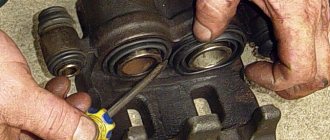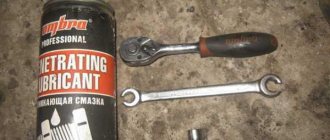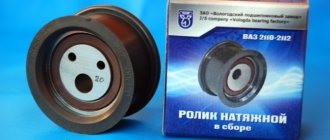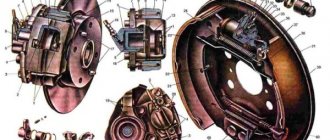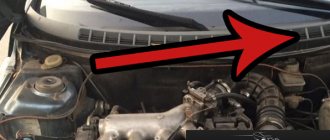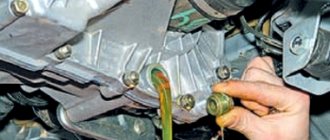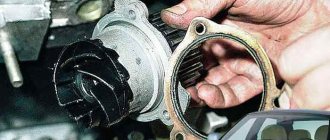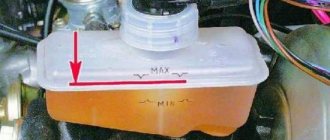Hi all. The thought came to me that before winter, it wouldn’t hurt to sort out the brakes. Lately, there has been a grinding noise when braking. An inspection of the brake system showed that the discs and pads were in good condition.
One of the reasons for grinding and rattling of calipers may be worn guides. Also, worn guides can lead to uneven wear of the pads (when one of the pads wears out faster than the other). This is exactly the wear that was on the old pads when they were last replaced.
Inspection of the guides showed that they are not jammed, but the lubricant has coked and thickened, and there is also noticeable play.
4 guides were purchased along with anthers, the price was 40 rubles per piece. And also a special lubricant for brake systems BOSCH SUPEFIT (5000000151) for 50 rubles. One bag is just enough for four guides.
It is important to know that not any high temperature grease will work for caliper guides. Do not use ceramic grease or copper-based grease. These lubricants coke and cause the guides to jam. They can also be aggressive towards anthers. As it turned out later, BOSCH lubricant is not suitable for guides; the temperature range is only -25°C +130°C, which is naturally not enough for this unit. Although the manufacturer claims that this lubricant is universal and is exactly suitable for guides. I found supporting information in the official brochure about the use of lubricant.
We'll ride it for now, and we'll see.
Before replacing the guides, remove the old grease and thoroughly wash the bracket. To remove the old grease I used 646 solvent.
Its disadvantage is that it is aggressive to the rubber from which the anthers are made, so after the solvent, I washed the staples with a degreaser. New lubricant should be applied in a thin layer.
Replacing caliper guide pins and their boots on VAZ 2114-2115
The first step is to jack up the front of the car. Then remove the wheel and use a flat-blade screwdriver to bend the locking washers of the caliper bolts.
Then unscrew the two fastening bolts at the top and bottom, as shown in the photo.
Next, compress the brake cylinder using a screwdriver by inserting it between the bracket and one of the pads.
Next, you can lift the cylinder with the bracket up, as shown below, and move it to the side so that it is out of the way.
And now you can easily remove the caliper pins, both from above and from below, with minimal effort.
Signs of faulty brake calipers
If brake fluid is leaking from the caliper, its level in the system will constantly drop. And when the level in the tank drops below the minimum, the sensor will trigger and the brake system fault light will light up on the dashboard.
If the piston is in good condition, then replacing the seal kit will be enough to eliminate brake fluid leakage from the caliper. Small areas of corrosion on the caliper piston can be removed by grinding its surface. In case of larger damage, you will have to purchase a caliper repair kit along with a new piston.
Replacing anthers and caliper guide pins on VAZ 2110, 2111 and 2112
First you need to unscrew the front wheel mounting bolts, jack up the car and remove the wheel completely. Then, using a flat-head screwdriver, bend the locking washers of the guide bolts, both from above and from below. Then unscrew the fastening bolt, holding the finger from turning it with a 17 mm wrench.
How to correctly replace the caliper guides of VAZ 2109-2115. How to replace caliper pins
When driving a VAZ
, you can often hear some kind of creaking noise from the front wheels. Where they are.
Inspection of the caliper (guides and boots) on Priora, Kalina, Grant and 2110, 2114
Guide lubrication
caliper
pins ,
replacement
of pins and boots, video review of repairs. For all cars.
Diagnostics
To check the front brake caliper of the VAZ-2110, you will need to perform the following steps:
- Assess the condition of the metal piston and the ease of its movement inside the cylinder.
- Check for metal oxidation, oxide formations or build-ups, or moisture on the elements.
- Assess the condition of all rubber boots.
- Check the condition of the VAZ-2110 caliper guides. You must make sure that there is no abrasion, deformation or scuffing on their surface.
Any damage to the caliper body and its and other elements should alert the driver. In this case, it is necessary to change the mechanism.
Installing a new caliper
Installation of the device is carried out in the reverse order. To do this you need to do the following:
- Install the brake caliper housing and tighten the mounting bolts.
- Tighten the bolts using a 17mm wrench.
- Push back the locking plate and unscrew the bolt with a 13mm wrench to remove half of the caliper.
- The piston must be completely pressed inside the mechanism and new brake pads must be installed.
- Reinstall the caliper half and tighten the nut. Bend the locking plate using a chisel.
- Screw on the brake hose.
- Bleed the entire system to get rid of any air in it.
After bleeding the system, it is imperative to put rubber plugs on the fittings. With their help, these elements are protected from moisture and dust. And the next time you pump, unscrewing the fittings will be much easier.
What does the price depend on?
In addition to the brand, the following product parameters are involved in determining the consumer price:
- Total area of the brake wheel cylinder.
- Fixed caliper dimensions with fixed mounting holes (standard caliper fits 13″ stamped wheel rim).
- Dimensions of the movable bracket.
- Material of guide pins for movable bracket.
- Locking plate material.
The caliper for VAZ 2109, 2110, 2114, 2115 has a single-piston design , therefore it is the cheapest in its class. Among the additional pricing factors it is worth noting:
- Availability of a brake hose (reinforced, regular).
- Implementation of a casing-channel for laying hoses.
- Availability of spare bolts securing the working cylinder to the movable bracket.
Checking caliper pistons and cylinders
If the inspection shows that the guides are in order and the wear of the pads is even, attention should be transferred to the caliper cylinders. First of all, you should inspect them for brake fluid leaks. The presence of these indicates wear of the seals. In this case, it is necessary to replace the caliper assembly, since its repair at home is practically impossible with the required efficiency.
Thanks for subscribing!
If, when you press the brake pedal, the pistons do not come out of the cylinders or do not return after releasing it, still pressing the pads against the discs, this indicates that they are souring. In this case, you can try to restore normal operation of the caliper (see article Prevention of brake calipers ) or immediately replace the caliper with cylinder and piston assembly.
Before checking the functionality of the guides and pistons of the front calipers, be sure to check the other elements of the brake system, the failure of which can lead to similar symptoms. When diagnosing the condition of brake calipers, pay special attention to the condition of the guides and pistons.
Types of installed calipers and their prices
The same caliper is installed on a given family of cars, with the exception of the index in its marking, indicating the model of the vehicle body. Otherwise, these are identical brake devices that have a single-piston design independent of the fixed caliper. A similar modernization took place after 2001, and the last half calipers with 4 pistons were installed on the VAZ 2108.
The cost of a caliper for a VAZ 2109, 2110, 2114, 2115 can be as follows, based on its condition:
- New – 1,610-4,270 rub .
- Used – 700-1,980 rub .
- Refurbished (restoration using original components) – 1,420-2,190 rubles .
Repair kits
You can purchase special kits designed for caliper repair. But there is no point in purchasing it. It is much better to replace the VAZ-2110 caliper. In this case, you will increase the life of the entire braking system and also improve its reliability. Such repair kits contain the lubricant that is necessary for the piston and guides.
You cannot use graphite lubricant such as CV joint or Litol-24, as this will cause the protective shock absorbers to swell and the guides to simply oxidize. As a result, repairs will not bring the desired effect for a long time.
Where and how to buy?
You can buy a caliper at any auto store that specializes in selling components for domestically produced cars. As a rule, in such stores all goods are in stock. You can select a suitable caliper either by writing out its markings, or rather the final index of the last 5 digits, or by providing the seller with a faulty caliper (the weight of the product is only 2.17 kg ). Approximately once every 3 years, the suspension of cars of the 2109-2115 family was updated, therefore, the location of the mating threaded seats (mounting bolts) may vary slightly.
New ventilated brake discs are compatible with all mentioned calipers for VAZ 2109, 2110, 2114, 2115. The installation is fully consistent with original components.
Sources
- skolkos.ru/skolko-stoit-support-na-vaz-2109-2110-2114-2115/
- drive2.ru/l/510984286187290783/
Repair
The first rule: if you don’t want further troubles, especially when one of the wheels jams, never repair only one caliper, always both together!
To sort through, repair or replace individual parts, and possibly completely change the unit if it turns out that there is nothing left to repair, you need to follow the following algorithm:
- Remove the ring securing the cover, and then the cover itself;
- To avoid damaging anything, place a piece of wood or a rag between the caliper and the piston, then remove the piston. Also watch your fingers - parts of the mechanism can press them;
- After removal, pay attention to the piston and cylinder. If you find any damage on them, then the entire assembly needs to be replaced;
- If everything is fine, using a wooden or possibly a plastic tool, remove the piston seal from the caliper cylinder;
- If you have a PD51 model, you need to squeeze out the bushing, remove the covers protecting from dust on both sides;
- All elements should be washed with a liquid intended specifically for cleaning brake mechanisms;
- You probably purchased a repair kit. From this, “push” a new seal onto the piston, then place it in the cylinder. This must be done without using brute force, otherwise the brake mechanism may subsequently jam;
- Install the piston dust cover - a new one, from the repair kit;
- The bushings must be lubricated with silicone grease, which is also included in the repair kit, then installed in the corresponding holes;
- Install the dust covers in their proper places;
- Before installing the caliper on the car, replace the copper gaskets on the hose connection.
The front brakes can now be completely reassembled. A prerequisite after repair is to bleed the brakes.
All that remains is to check whether the wheels lock properly when you press the brake pedal, and whether the caliper is sticking. Everything is fine? So, you can hit the road.
Source
What types of lubricants are there?
Caliper lubricants can be divided into several different types, each of which contains several lubricants that correspond in their characteristics to the operating conditions of various elements of the disc brake caliper.
Synthetic or mineral pastes with added metals
In the first group, it is worth considering high-temperature lubricating pastes with Anti-Seize properties. These lubricants contain a fully or semi-synthetic and mineral base. With the addition of synthetic thickeners, submicron particles of metals such as molybdenum or copper. Instead of metals, solid substances of lubricants can be used, which work successfully at super-temperature values. This group includes:
- Complex lubricating paste products.
- Metal-free pastes.
- Lubricants containing copper or molybdenum disulfide.
They can be used to cover anti-squeak plates, pressure springs, and the back side of the pads.
These are pastes from such brands as Huskey, Loctite, Wurth, LIQUI MOLY, Textar, Mannol Kupfer, Valvoline Cooper, Motip Koperspray, Bosch SUPERFIT.
What's good about a disc brake?
The main advantages are as follows:
- Compared to a drum, a disc is more reliable, and the braking is “sharper”, due to which the braking distance is reduced;
- The pedal responds faster after pressing;
- The system cools better, which is important when driving in conditions where you need to brake frequently;
- Very convenient to operate and repair, such brakes are easier to dismantle;
- They do not freeze after driving into a puddle of water or after washing.
Checking the caliper guides (“fingers”) of Lada Kalina (VAZ 1118)
If after these measures the problem remains, you can proceed directly to caliper diagnostics . In this case, the cylinder and the guide pins (“fingers”) deserve special attention, along which the caliper moves when the piston exits the cylinder to compress the pads. The first sign of poor performance of the guides is their heavily contaminated surface, which impedes the movement of the caliper. This is also evidenced by uneven wear of the inner and outer front brake pads - it should not exceed 5 mm.
If you find similar symptoms, it is better to replace the caliper guides. Their cost together with all the washers and anthers is low and will not require any special expenses. The operation to remove them and install new “fingers” will take no more than an hour, provided that all four guides are replaced. If desired (or lack of spare parts), you can try cleaning the old guides.
Installation of calipers from Volga on VAZ 2110
| There are never too many 'brakes', so many are trying to improve their efficiency by replacing the original brake discs and pads with alternative, imported ones. There are also more advanced modifications to the brakes, for example, installing GAZ 3110 brakes on a VAZ 2110. |
Brakes GAZ 3110 and VAZ 2110, what is the difference?
The negative aspect of switching to more massive calipers from the Volga is in weight. For example, the weight of a VAZ caliper with pads is 3.2 kg, and the weight of a Volga caliper with pads and adapter is 5 kg. That is, by replacing the standard 'tens' calipers with Volgov calipers, we increase the amount of unsprung mass of the car.
What does it mean? The smaller this value is, the less impact driving on uneven roads has on the smoothness of the ride. In other words, the heavier the body relative to the wheel, the faster the wheel will return to its permanent contact point after leaving the road. Therefore, designers of modern cars strive to reduce the amount of unsprung mass as much as possible.
The positive aspect of the Volga brakes is that the large pad area allows for better heat dissipation. Car enthusiasts also note their better efficiency compared to standard VAZ 2110 brakes.
Adapter for GAZ 3110 caliper for VAZ with front-wheel drive
Drawing of an adapter for the Volga caliper for VAZ 2108/2110/1118/2170 (AutoCAD format)
In the archive there is an adapter for brake discs R14 and R15, archive password: lada2111rf
Gas 3110 from storage. Automobile equipment surplus, used sale.nelikvidi.com
Installation of calipers from GAZ 3110 to VAZ 2110 (R15)
You will need: Volga calipers along with pads, an adapter for Volga calipers on a front-wheel drive VAZ (2 pcs), caliper hoses from a Chevrolet Niva (short).
Procedure:
Remove the caliper along with the bracket, and then disconnect the hose from the tube. Drill out the hole in the bracket on the body that holds the connection between the hose and the tube. This is done in order to thread the hose fitting. Connect one end of the hose to the tube. The other end is with a caliper.
Next, screw the adapter to the guide of the GAZ 3110 pads using M12x25 bolts with a pitch of 1.25 (it is advisable to use bolts with the letter 'X') and M12 bolts. Then screw the adapter with the guide to the steering knuckle using standard M10x25 bolts, pitch 1.25. Install the Volga pads, having previously cut off the wear sensor wires from them. Install the caliper. The bleeding fitting must be at the top, otherwise it is impossible to bleed the brakes. All that remains is to bleed the brakes, and here it is worth considering that with GAS calipers, more brake fluid is poured into the system.
Installation of calipers from GAZ 3110 to VAZ 2110 (R14)
In general, the installation is similar, but there are a number of points that are worth paying attention to: 1. Due to the fact that when installing R14 brake discs, the guide will move towards the steering knuckle, so we saw off the edges of the boot using a grinder
2. The adapter is used for R14 brake discs. Bolts should be used 5mm shorter, M10x20 pitch 1.25 with an M10 lock washer. Otherwise, the bolt will press the adapter against the brake disc and the disc will not turn.
3. The Volga’s caliper is larger than that of the “ten”, so you have to install a disc with a different offset, in this case the ET35 offset. An 11mm spacer for the wheel rim is also used. When installing disks, the seat may cling to the disk guide; in this case, you can grind the guide or use a spacer of the required thickness.
Conclusion
The negative point, which is the large weight, in practice does not affect the behavior of the machine. And the performance of brakes with GAZ calipers is significantly better.
By the way, this is not the only way to tune the brakes; rear disc brakes are very popular, as well as simply replacing brake discs from R14 to R15.
How to repair a caliper on a VAZ 2108-VAZ 21099?
Disassembly: 1) At the very beginning of the operation, you will need to remove the caliper itself from the car in order, firstly, to check its condition, and secondly, to replace everything that does not work on it. (For information on how to remove the caliper, see the article entitled: “Replacing the brake caliper on a VAZ”)
Note! Before removing this unit, make sure 100% that it is not working, to do this, first just look at its condition; no defects are allowed, after which you can ask another person (if you have one) to get into the car and press the button several times brake pedal, and at this time you will have to observe the work of the very piston that is inside the caliper, it will have to move and therefore the brake pads (Indicated by green arrows) will have to tightly grip the brake disc, which is indicated by blue arrows (This is by the way it will be possible to look through the gap in the caliper, which is indicated by a red arrow in the photo below), and when the pedal is released, they will definitely have to unclench and, as a result, move away from the brake disc without interfering with its rotation!
What is lubricated and why?
The caliper is a unit that loves lubrication. It is applied to the guide pins and the top of the pistons under the boot to protect against corrosion and prevent jamming. The non-working and end surfaces of the pads are treated with a special squeak-eliminating compound. All these are important and responsible measures on which the operation of the brakes depends. For example, the loss of mobility of a guide rubbing “dry” causes increased wear of the pad. Need I say that with lubricated pistons the system is more responsive?
Brake fluid
Any brake fluid that is used in automotive systems absorbs moisture very well. It is hygroscopic, therefore it oxidizes the piston mechanism from the inside, which leads to failure of structural elements. This makes the piston stroke more difficult and the brake pads wear unevenly.
The front wheels may become jammed. For these reasons, it is necessary to replace the brake fluid. Its service life is about 90,000 km, but not more than two years. These solutions contain many useful additives that improve cooling and increase braking efficiency.
But over time, under the influence of high temperatures and pressure, these additives evaporate. And the consistency of the brake fluid becomes more like water, and this reduces the efficiency of the system.
